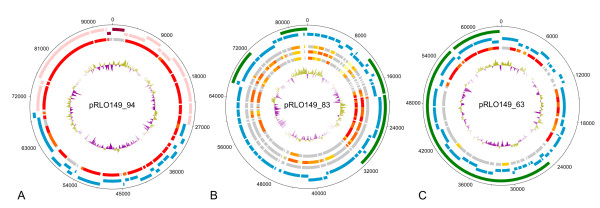Figure 2.
Circular plots of the plasmids of R. Litoralis. A-C: The inner rings display the G+C-content with violet areas below average and olive areas above average. Orthologous ORFs in other organisms (red and grey bars) are according to the Needleman-Wunsch-algorithm. The shade of red illustrates the value of the algorithm with red bars representing the ORFs with the best conformity to the respective ORFs of R. litoralis and the grey bars showing the ORFs that have no orthologs in the respective organism. A: Plasmid pRLO149_94 of R.litoralis. Rings from the outside to the inside: 1 and 2: ORFs on the leading and complementary strands, respectively. Pink ORFs are associated with photosynthesis, blue ORFs have different functions, dark red ORFs show the replication genes of the plasmid. 3: orthologs in the genome of R. denitrificans. All orthologs can be found on the chromosome of R. denitrificans with ~60 kb being syntenic. Only nine ORFs do not have orthologs in the genome of R. denitrificans including the replication genes of the plasmid. B: Plasmid pRLO149_83 of R. litoralis. Rings from the outside to the inside: 1: predicted alien genes on the plasmid; 2 and 3: ORFs on the leading and complementary strands of the plasmid, respectively; 4-6: orthologous ORFs in R. denitrificans, D. shibae and R. nubinhibens in the order of appearance. Nearly all orthologs in the two latter organisms are also encoded on plasmids. C: Plasmid pRLO149_63 of R. litoralis. Rings from the outside to the inside: 1: predicted alien genes on the plasmid; 2 and 3: ORFs on the leading and complementary strands of the plasmid, respectively; 4: orthologous ORFs in R. denitrificans. The orthologs in the genome of R. denitrificans are all located on the 69 kb-plasmid of the organism. More than half of the plasmid encodes putative alien genes.

